Article and Photos by Rich Thom
The SV&W NMRA Clinic’s first meeting of the new year, held on January 11th, was all about an item which many layouts just can’t have enough of: trees. Several folks brought in a variety of trees and tree-making materials and gave demonstrations, with the hope that other attendees would try their hand at making a tree using one of the methods shown. However, few rose to the challenge! Nonetheless, the variety of materials and techniques was instructive and we’re sure that all picked up some new ideas.
Before the hands-on demos, Rich Thom gave a short presentation about the challenge of mounting trees (fir trees, in his case, modeling a northwest short line) in hardshell scenery. Especially those in foreground scenes, in front of trackage where switching will take place, putting the trees at risk of being easily damaged during operating sessions. The solution? Magnets. See Fig 1.
Rich thanks fellow SV&W clinic contributor Al Frasch for the idea. On Al’s well-known N-scale Pilchuck Division of the BNSF in Freeland, his signal masts are mounted on magnets; if they get bumped, they pitch over but aren’t damaged. Why not use the same idea for foreground trees? Works great! Rich epoxies 3/8 in. dia. magnets (see Fig 1 for source, which he found at Home Depot) to the trunks of his fir trees, clamping the trees in a soft-jawed vise.
Obviously, you need to embed some sort of base in the hardshell for the trunk magnets to magnetically mate to. You can use anything ferrous: steel washers, hex nuts etc. Rich settled on blackened 14 x ¾ flat head wood screws (Fig 2). These give some “tooth” for epoxying into the hardshell. Rich drills a pilot hole, applies epoxy, inserts a screw, attaches the tree, and then straightens the tree while the epoxy cures with one or more wood braces and pins (Fig 2).
Fig 3 shows three tall firs on their magnet bases “ready for accidents” when crews on Rich’s layout switch the logging spur behind them. Yet to do: painting the outer surfaces of magnets and bases, and covering with foliage or ground litter.
Cliff Aaker was next up with a demonstration of making bottlebrush trees, a variation of Tom Hawkins’ demo at our clinic last October. In Fig 4 Cliff (left, who apparently has four arms) twirls the fiber strands into the wire trunk with the aid of Curt Johnson at right. The bristles Cliff is using here — “Chungking Boiled Bristles” (seriously) — were from MicroMark but are reportedly no longer available. No matter, rope fibers or other similar fibers work just as well, although Chungking Boiled Bristles (package labeling almost entirely in Chinese) just have to be cool if you can find them.
Cliff brought another tree (which unfortunately your GI reporter failed to photograph properly) — a tall fir — with very convincing foliage. Cliff said the material was available at Home Depot and labelled “natural furnace filter material.” In fact, it’s just hog hair. And, Cliff added, hair embedded with the debris and other “stuff” one might expect a hog to collect while it wallows the day away. Nevertheless, it makes a fine-looking tree. You tease the hair, just like other furnace filter or scrub brush material, and slip it down, in layers, onto the trunk. Cliff uses cedar shakes, available everywhere, as his raw material for coniferous tree trunks.
All sorts of tree-making materials were brought in (Fig 5) underscoring that sources abound — no need for Amazon.
Rich Blake followed. Rich is fortunate to have in his possession a module built by our region’s legendary Paul Scoles, and other items as well including some of the trees that Paul made, including a madrone and a small pine (Fig 6). “Small” in the sense that, to anyone who was lucky to have visited Paul’s layout, a large grove of very tall pines indeed towered over visitors at one spot. This opened up a general discussion of tree-making. For deciduous trees there are several choices for armatures: the popular supertrees; dried salal branches (plentiful in these parts); even—offered ex-Nebraskan Mark Malmkar — sagebrush (not so plentiful in these parts). For coniferous trees, try pride of Madeira, a flowering plant native to the island of the same name. They make especially good representations of ponderosa pines.
Susan Gonzales described her years of tree-making, beginning with plastic armatures (mostly ugly!), graduating to super-detailed fir trees made using branches of caspia (Fig 7) which yield great results but with lots of time invested per tree. (Susan gave a hands-on clinic a couple of seasons ago on making great coniferous trees using caspia.) For background trees, Susan told a story about teaching children to easily make trees with sedum — a common large genus of flowering plant. The kids loved it — dipping the dried blossoms into glue, then sprinkling coarse foam foliage and “voila” — trees. The children reveled in the mess, but for adults, not a bad way to quickly make dozens of background trees.
During and after the demos, a few stalwart attendees had a go at making a tree, including Doug Lingenbrink (Fig 8). Doug’s bottlebrush tree, like a sedum tree, is probably best placed in the background — somewhere way, way back.
Footnote: We all try to support local suppliers when we can. For trees (tonight’s subject) and a wide range of other model railroad supplies, try Xtrains Model Train Supplies at www.xtrainsmodeltrains.net. Proprietor Mike O’Brien is an active member of our “sister” Mt. Vernon NMRA Clinic.

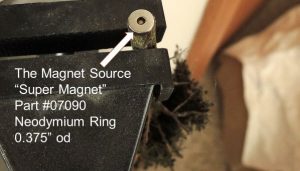

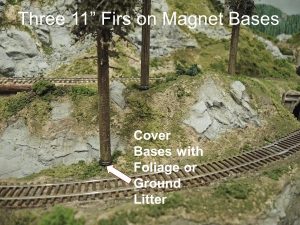
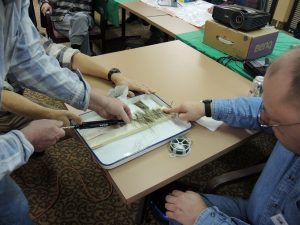
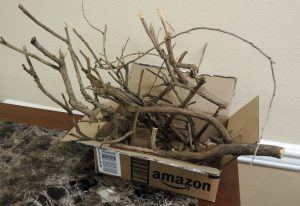
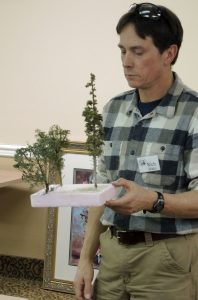
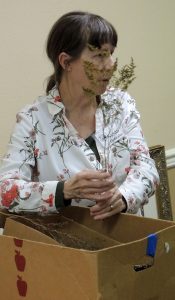
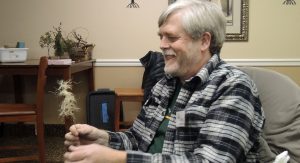
No Comments Yet